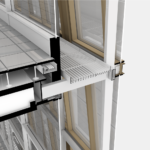Southern Cross Station, Melbourne

View of Southern Cross Station in Melbourne from Street
The redevelopment of Melbourne’s Southern Cross station, formerly known as Spencer Street Station, was driven by the need for an upgraded terminus in the expectation of a rise in passenger numbers in the future.
The design brief specified a fully-integrated transport exchange which would upgrade existing public transport routes and pedestrian connections between Melbourne’s CBD and the developing Docklands area. The new connection would stimulate regeneration and boost local commerce.
In terms of aesthetic, the brief required a ‘visually-inspiring’ structure, an icon for the city, which would at the same time to provide fully-sheltered access in all parts of the station.
In terms of performance, the practicalities of accepted station design required the ease of passenger circulation, a fully-covered concourse, and an improved working environment for staff. Fulfilling the basic requirements of a station, the new design would include a high-quality ticketing area, baggage-handling, waiting and retail services, as well as an abundance of comfortable seating, lighting and passenger information display systems.

Elevation and Cross-Section Drawings of Southern Cross Station
.
Design Response
The architect’s response to the brief was a vast hall covered by a distinctive undulating roof, which serves as both an iconic and practical solution. The open space beneath permits uninterrupted vistas in every direction and visual interconnection between different streets surrounding the station for greater legibility for users.
Any smoke exhausted from trains that frequent the station is channelled to the roof high points, where it can be transferred outside the building envelope.
Set within the roof are long lines of Texlon ETFE cushions, a cost effective, semi-transparent roofing solution. The Texlon system allows enough light into the building envelope for natural illumination, but controls the glare from the highly reflective roof structure which could cause discomfort to users beneath
3D Structural Model showing Connection of Column with Roof Structure









